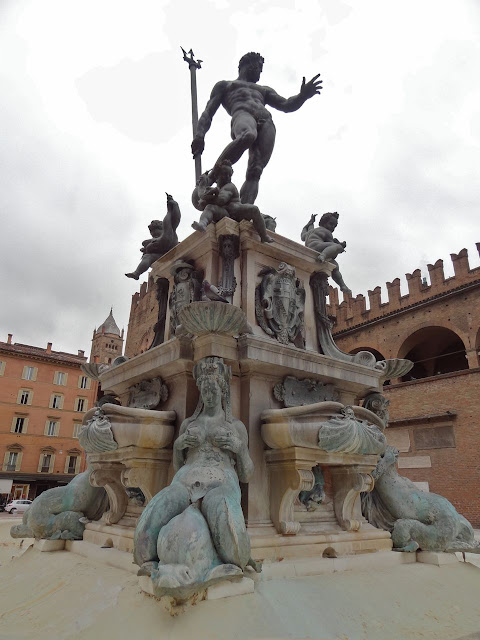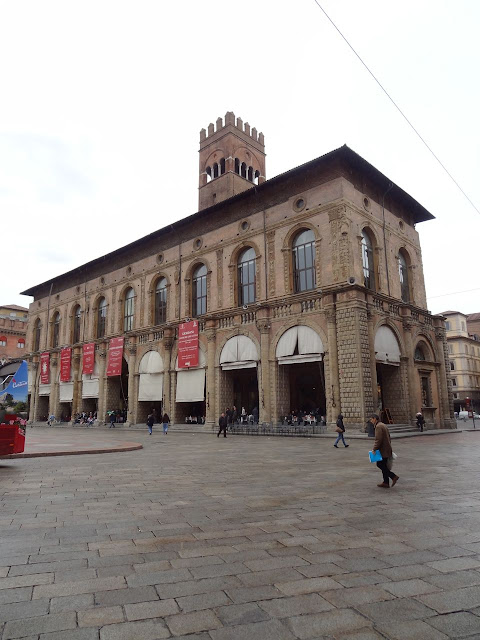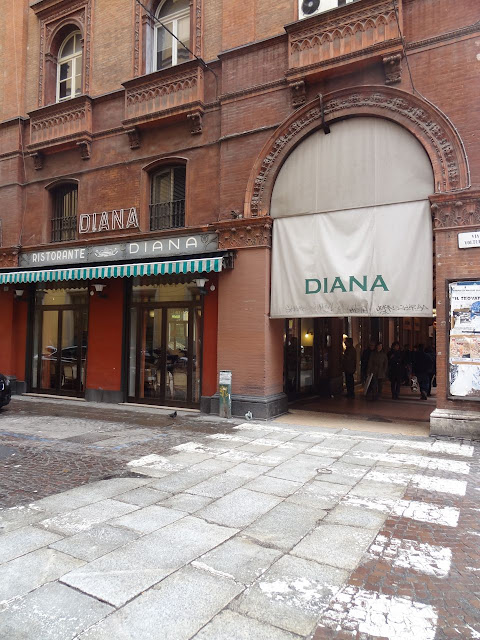Bologna is a microcosm of everything that’s fabulous about Italy: friendly residents, walkable sites, beautiful architecture and amazing food. Even in Italy, a country that takes food very seriously, Bologna stands out. Its chamber of commerce preserves centuries-old recipes, and the city’s nickname, La Grassa, means 'the Fat One.' Bologna is an omnivore’s dream. The list of foods originating in Bologna and the surrounding area — lasagna, tortellini, 'spaghetti bolognese', Parma ham, balsamic vinegar, parmesan cheese — reads like a what’s what of Italian cuisine. The food in the Emilia-Romagna region is less about tomatoes and olive oil and more about butter and cream, which makes it a great place to visit in the cold weather of March, when we made our pilgrimage to the 'Fat One'.
Bologna is known for its miles of portici, or covered terracotta arcades
The historic city centre is a handsome ensemble of brick buildings and charming porticoes and colonnaded streets. Medieval palaces are clustered around two central squares, Piazza Maggiore and Piazza del Nettuno, flanked to the south by the Churches of San Petronio and San Dominico.
Fontana del Nettuna - Neptune's Fountain
A saucy detail of the Fontana - her breasts actually squirt out water
when the fountain is running!
Palazzo Communale in Piazza Maggiore
The archway through Piazza Communal
Over the archway is a statue of Bologna born Pope Gregory XIII,
most famous for reorganizing the calendar
Palazzo 'Re Enzo' on Piazza Maggiore, once home to King Enzo of Sardinia,
who was imprisoned here in 1272
Basilica di San Petronio on Piazza Maggiore, currently being refurbished
Interior of the Basilica
The famous towers of Bologna, 'Le Due Torri' - Asinelli and Garisenda - are mentioned by Dante in The Inferno, and stand side by side in the very compact and bustling Piazza di Porta Ravegnana. In the Middle-ages, every family of importance had a tower as a symbol of prestige and power, and as a potential fortress. There were originally more than 200 towers in Bologna, and even now more than twenty, dotted around the city centre, can still be found. Asinelli Tower is the taller, and was built between 1109 and 1119 by the family of the same name, and leans almost 8-feet off it's vertical axis. The Garisenda Tower is the shorter of the two, and tilts even further, more than 10-feet!
Le Due Torri - Torre Garisenda and Torre Aisinelli
Bologna is full of colonades, this one in the bustling area
in the University of Bologna neighbourhood
One wall in the University area was plastered with flyers
for 'Rooms for Rent' for the enormous student population
The exterior of Tamburini, Bologna's most famous food emporium
Inside is a mecca of top-quality cured meats, succulent cheeses
and glorious selection of homemade pastas
Tamburini's homemade Tortelloni di Zucca
Fresh roasted pork and veal ready to be packaged up and taken home
'La Baita' is Bologna's ultimate formaggeria
A cornucopia of Bolognese specialties beckon
A food lovers paradise with legs of Prosciutto Parma hanging from the ceiling
along with chandeliers
La Baita has its own version of Parmigiano called 'Sua Mesta il Nero'
and a delicate 'squacquerone' which is a soft and creamy cows milk cheese
A temple of Bolognese cuisine, Ristorante Diana on Via Independenza 24, is Mario Batali's favourite restaurant in Bologna. With a city that is overwhelmed with fabulous cuisine, and we had a list of esteemed culinary competitors to consider, we decided to try Chef Mauro Fabbri's restaurant in the heart of the city. With any of northern Italy's better restaurants, it's always best to reserve ahead. But, given that it was March, chilly and wet, we tried our luck and were fortunate enough to get a lovely spacious table for four, for just the two of us.
Ristorante Diana, Mario Batali's favourite restaurant in Bologna
- so we had to try it!
The sophisticated interior was full of affluent Bolognese
and the occasional Canadian tourist...
Our gracious table for two at Diana's - it pays to arrive by 12:30
to get one of the better tables
The menu was extensive and every dish sounded mouth-wateringly tempting -
needless to say, we only ate one meal day
Coppia Ferrarese, Emilia-Romagna's uniquely-shaped twisted bread
As we considered Diana's mouthwatering menu, we ordered a half bottle of Lambrusco, Italy's answer to Rosé. A dry (secco) sparkling red wine that's made in Emilia-Romagna, we originally felt obliged to give it a try, and were quickly won over by its light bouquet, dry finish and affordable price. At between 6 and 12 euros a bottle, we found that many Italians were drinking this light wine at both lunch and dinner, and we began to do the same. The question becomes whether we'll be able to find Lambrusco when we get home to Canada, and if we do, if we'll be given queer looks for asking for a sparking red wine. But as 'they' often say, 'don't knock it until you try it.' You'll be surprised — I was, and am a Lambrusco convert.
A mezzo, or half bottle, of Lambrusco to begin our sumptuous lunch
Affetata Mista con Mortadella "Dei Torri" Alcisa: a mixed cured meat platter
of prosciutto, shaved mortadella, cured salumi and paper thin slices of a pork terrine
A bottle of Sangiovese Cesari Riserva was the perfect choice with our decadent lunch
Gnocchi con Speck e Porcini - light, pillowy and unbelievably delicious
Lasagna Verde al Forno
Carello degli Arrosti, the hand-carved and customized plate of roast meats
from the trolley: pork, tongue, turkey and more - a specialty of the region
along with Carello degli Bollita, which are all boiled meats
Diana's Arrosti Mista
Grilled Entrecote
A contorni, or side, of Carciofi al Tegume: poached local artichokes
dressed in a vinaigrette
a second contorni - Patate Rosti
Torta di Risa: a uniquely traditional Bolognese dessert made with rice, spices,
dried fruit, eggs and cream - "As my Nonna used to make," our server told us
The Maitre'D with the dessert trolley, serving my homemade vanilla gelato
served with a compote of sundried local cherries
Vanilla gelato with sundried local cherries - like many dishes we enjoyed,
they make look like hell, but my God they're phenomenal!
These were the most flavour-packed cherries I've ever eaten
One the way back to our car after dining at Diana's, we chanced upon 'Laboratorio Privato della Trattoria Anna Maria,' where we discovered Anna Maria Monari of Bologna's Trattoria Anna Maria, making pasta in her small shop a few doors down from Trattoria del Rosa. The rumour is that Trattoria del Rosso is the oldest and best trattoria in town. Written up in Bon Appetit Magazine, Trattoria della Rosa was one of 'the' Bologna restaurants worth a visit. Next time we're in Bologna, we'll definitely make a point of trying her homemade tortellini, but at the very least, I saw her making handmade tortellini!
Written up by Bon Appetit Magazine a while ago, Anna Maria's restaurant
was on my culinary radar, so I was thrilled to chance upon it on Via Belle Arte in Bologna
Anna Maria Monari making the tiniest imaginable tortellini, for her restaurarnt
Trattoria Anna Maria on Via Belle Arte in Bologna - what a privilege to catch her in her craft
Anna Maria's small ristorante
Although we didn't have the opportunity to try Anna Maria's pasta, we did take home two packages of homemade pasta from Tamburini: Capellaci di Porcini and tiny totellini for two sumptuous meals we would look forward to enjoying at Villa Mazzino in the hills of Tredozio.
Our two beautifully wrappped packages of homemade pasta from Tamburini in Bologna,
in front of our fireplace at Villa Mazzino - yum!



















































































